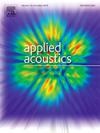The impact of sensor mismatch errors on the robustness of circular directional differential microphone arrays
IF 3.4
2区 物理与天体物理
Q1 ACOUSTICS
引用次数: 0
Abstract
Circular directional differential microphone arrays (CDDMAs) are composed of directional microphones, and the mismatch error of the microphones may lead to a significant degradation in array performance. The effects of the gain and phase mismatch errors of microphones on the mainlobe directivity of first-order and second-order CDDMAs are analyzed theoretically in this paper. The theoretical results are verified by simulation. The results indicate that, for the first-order CDDMAs, similar to the first-order circular differential microphone arrays (CDMAs) which are composed of omnidirectional microphones, the gain errors of directional microphones do not alter the mainlobe direction of the beampattern. However, unlike the CDMAs with omnidirectional microphones, the phase errors of the CDDMAs with directional microphones also do not change the mainlobe direction of the beampattern. For the second-order CDDMAs, both gain and phase errors can cause deviations in the mainlobe direction or even mainlobe orientation reversal. Nevertheless, the CDDMAs exhibit better robustness than that of the CDMAs in terms of beampattern, directivity factor, white noise gain and front-to-back ratio, especially in the low and middle frequency ranges.
传感器失配误差对圆形定向差分传声器阵列鲁棒性的影响
圆形定向差分传声器阵列(cddma)由定向传声器组成,传声器的失配误差会导致阵列性能的显著下降。本文从理论上分析了传声器增益和相位失配误差对一阶和二阶cddma主瓣指向性的影响。通过仿真验证了理论结果。结果表明,与全向传声器组成的一阶圆差分传声器阵列(cdma)类似,定向传声器的增益误差不会改变波束方向。然而,与带全向麦克风的cdma不同,带定向麦克风的cdma的相位误差也不会改变波束方向图的主瓣方向。对于二阶cddma,增益和相位误差都会导致主瓣方向偏差甚至主瓣方向反转。然而,cddma在波束方向图、指向性因子、白噪声增益和前后比方面表现出比cdma更好的鲁棒性,特别是在低频和中频范围内。
本文章由计算机程序翻译,如有差异,请以英文原文为准。
求助全文
约1分钟内获得全文
求助全文
来源期刊

Applied Acoustics
物理-声学
CiteScore
7.40
自引率
11.80%
发文量
618
审稿时长
7.5 months
期刊介绍:
Since its launch in 1968, Applied Acoustics has been publishing high quality research papers providing state-of-the-art coverage of research findings for engineers and scientists involved in applications of acoustics in the widest sense.
Applied Acoustics looks not only at recent developments in the understanding of acoustics but also at ways of exploiting that understanding. The Journal aims to encourage the exchange of practical experience through publication and in so doing creates a fund of technological information that can be used for solving related problems. The presentation of information in graphical or tabular form is especially encouraged. If a report of a mathematical development is a necessary part of a paper it is important to ensure that it is there only as an integral part of a practical solution to a problem and is supported by data. Applied Acoustics encourages the exchange of practical experience in the following ways: • Complete Papers • Short Technical Notes • Review Articles; and thereby provides a wealth of technological information that can be used to solve related problems.
Manuscripts that address all fields of applications of acoustics ranging from medicine and NDT to the environment and buildings are welcome.
 求助内容:
求助内容: 应助结果提醒方式:
应助结果提醒方式:


